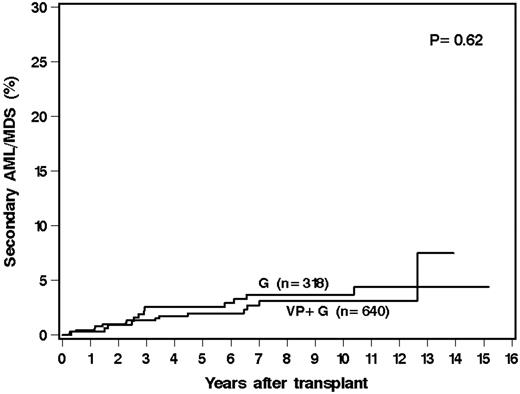Abstract
Abstract 2264
Poster Board II-241
Prior studies have demonstrated that high-dose etoposide followed by granulocyte colony-stimulating factor (VP+G) significantly improves peripheral-blood progenitor cell (PBPC) mobilization for autologous stem cell transplantation (ASCT) compared to granulocyte colony-stimulating factor (G-CSF) alone. We compared the safety and effectiveness of VP+G to G-CSF alone for PBPC mobilization in patients (pts) with non-Hodgkin lymphoma (NHL) and Hodgkin lymphoma (HL) who underwent ASCT at the Cleveland Clinic and Ohio State University. Primary end points were CD 34+ cell collection, post-priming hospitalization for neutropenic fever and incidence of secondary hematologic malignancies. Secondary endpoints included relapse-free and overall survival. From 02/1992 through 06/2006, 640 pts who received etoposide (2g/m2) followed by G-CSF (10mcg/kg/day) and 318 who received G-CSF (10mcg/kg/day) alone underwent ASCT. Patients who had inadequate cell collection (<2×106CD34+ cells) were excluded. Mean age of pts receiving VP+G was 48 years and G-CSF alone was 45 years (p<0.001). Pts in the VP+G group had more prior chemotherapy regimens (p=0.036) and were more likely to have relapsed/refractory disease (p<0.001). The two groups were otherwise similar with respect to gender, bone marrow involvement and prior radiation therapy. In the group receiving VP+G, 331 patients (52%) are alive with a median follow up of 57.6 months (range, 3.3-166.9). In the G-CSF group, 153 (48%) patients are alive with a median follow up of 114.2 months (range, 15.3-181.9). In the VP+G group, median total CD34+ cells collected were 9.34× 106 / kg with 42% of all pts having adequate (2×106 cells/ kg) CD 34+ collection after 2 days of apheresis compared to a median CD34+ cells collected in the G-CSF group of 3.83× 106 / kg with only 16% pts having adequate collection after 2 days (p<0.001). Post-priming readmissions for neutropenic fever were required in 26% of patients in the VP+G group, none of which were fatal, and none in the G-CSF alone group. Time to neutrophil recovery (mean 10 vs. 11 days, p<0.001) and platelet recovery (mean 16 vs. 21 days, p<0.001) was shorter in the VP+G group. Following transplantation, incidence and causes of death within 100 days of transplantation were similar in the two groups. Secondary hematologic malignancies (AML/MDS) occurred in 15 pts (2.3%) in the VP+G and in 12 pts (3.8%) receiving G-CSF alone. The estimated incidence of secondary malignancies at 5 years was 2 % in the VP+G group and 2.6 % in the G-CSF alone group as shown below:
Priming regimen was not a significant variable for relapse-free or overall survival.
The present study shows that even when restricted to patients who collect adequate numbers of PBPCs, the addition of etoposide significantly improves the effectiveness of mobilization. This occurs at the cost of an increased incidence of neutropenic fever but with no mortalities. Following transplantation, there is no evidence of an increased incidence of secondary malignancies in pts receiving VP+G. Thus VP+G remains a safe and effective regimen for mobilization in pts with lymphoma.
No relevant conflicts of interest to declare.
Author notes
Asterisk with author names denotes non-ASH members.


